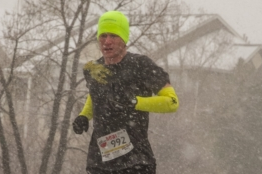The new menu item, Running Food Reviews, is up and live–check it out while you’re here.
One of my favorite events of the year is coming up. But first, how to prepare for running while you travel.
I love running when I’m on the road be it in London, Death Valley, traveling for business, or visiting family. How do you pack and prepare? This is pretty easy. When traveling, I have a few dedicated articles of clothing: a bright orange shirt, a bright white running hat, and a pair of shorts with a decent-sized zippered pocket. The first two items are all about visibility. People in some areas of the country may not be used to seeing runners and even if you’re on sidewalks, it’s good to make yourself as visible as possible. If I’m on a road and sidewalks are not an option, when I see a car coming, I’ll weave back and forth a little to add to my visibility. It may sound odd and look weird, but it’s better than getting smashed by a car.
For the shorts, the zippered pocket means I can stash my ID and credit card without them falling out, as well as a hotel key if that’s where I’m staying. It keeps my hands free so I don’t have to worry about dropping something if I need to push sidewalk crossing buttons or hold my hand up to make sure a car sees me. The items in your pocket can get sweaty. What to do? Stick in a few plastic baggies to wrap them in. If you fold them right, they’ll keep all the moisture off and you can toss the bags when you’re done.
If the weather is colder, I can either pack a long-sleeve short to wear under the bright orange one, or I have a bright yellow pullover. A hat and light gloves don’t take up very much room. Typically when I’m traveling, I’m keeping my runs to 3-6 miles so if my wardrobe isn’t complete, it may be a little less comfortable in cold or inclement weather but it’s not the end of the world.
So far when I’ve traveled, my running has occurred during daylight hours. If you know it will be dark when you run or you’re not sure, stick a flashlight or headlamp in.
I do a couple of things before I pack the car and/or head to the airport. I’ll take a quick look at Google Maps to get a sense of the area. Once I’m there, I may ask the hotel clerk if there are areas I should try, or avoid. If you’re staying with friends or family, they will have ideas for places you can go.
If you’re in a new area, you want to be focused on the run and staying safe. While you always need to use common sense and make sure you’re aware of what’s going on around you (enhanced visibility doesn’t make you car accident-proof) a couple of simple items can go a long way in helping you stay safe and running.
On to Badwater. I first learned about Badwater in 2005 and have enjoyed following the race ever since. All facts, numbers, etc. are from badwater.com (except for the Scott Jurek and Marshall Ulrich details which are from their Wikipedia pages).
The course and start times have seen a couple of changes over the years. This year’s race is on July 23rd and goes from Badwater Basin to Whitney Portals. 99 runners will leave in equal-numbered waves at 8:00 p.m., 9:30 p.m., and 11:00 p.m.
I have never run the race or seen it in person. If you look at the last point under the spectator section, they actually request that spectators not attend. However, they do have a webcast and more recently added GPS trackers to the runners so you have stride by stride updates on the race. There is also a Twitter feed.
Given how poor internet and cell reception are in Death Valley, it can be a tricky race to follow. But, it’s a lot of fun. The first time station is in Furnace Creek, 17 miles from Badwater Basin, so the initial splits don’t come in for a few hours. As the race moves along, it’s a full day of checking time splits, looking at the Twitter feed, and watching as some runners, even seasoned veterans, fall back while others make up large chunks of time in the latter stages of the course. Many remarkable accomplishments have been witnessed here. Marshall Ulrich did the event self-supported one year, pulling a cart loaded with his own supplies and water (most runners have a multi-person crew with vehicles). Scott Jurek won the 2005 edition and set the course record a mere few weeks after winning his seventh straight Western States 100. Pam Reed was the first female to win the overall race in 2002 and repeated as overall champion in 2003.
This year’s race will feature many Badwater veterans, including past champions and runners up: Pete Kostelnick, Oswaldo Lopez, Amy Costa, Brenda Guajardo to name just a few. You never know how it will turn out. Enjoy following it.
Running food review of the week: (note–gels, bars, chews, and other items affect everyone differently. Try them on a short run before using them for a key training run or race): Mandarin Orange Gu. This one is interesting. For the flavor, it has an orange flavor when you first eat it, but the mandarin-orange specific flavor hits more as an aftertaste. The important factor, does it work, is a yes. It does give a pleasant boost of energy.
Badwater recap next time, leading off with my own Death Valley running adventure…










